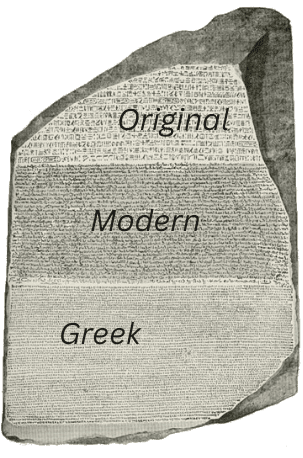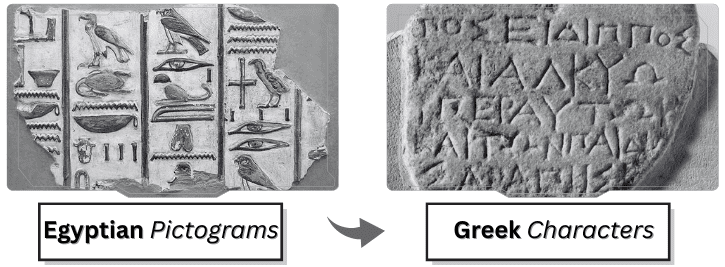The Power of Translation and its Impact on Global Commerces
Throughout history, translation hasn’t always happened between books; it’s often happened between people. In moments when entire worlds collided, a single voice could change the course of history.
Translators weren’t just interpreters of words, but of cultures, emotions, and power itself.
Two remarkable women, separated by centuries and continents, embody that truth: La Malinche in 16th‑century Mexico and Sacagawea in early 19th‑century North America.
Both stood at the crossroads of empires and survival, their words quietly shaping destinies.
Birth of Language
From Sounds to Speech: How Communication Shaped Humanity
Human language is our cooperative superpower, the skill that once allowed hunters to move as one, silently tracking prey and sharing intent without a word. These early forms of communication laid the foundation for communal culture, shared beliefs, and eventually, civilization itself.
Sign language proves that understanding doesn’t need sound. Early humans combined gestures and calls, often mimicking nature’s rhythms to coordinate without alerting their prey. Echoes of those ancient tactics remain today in modern militaries, where silent signals still ensure precision and unity without exposing position.
So how does this connect to your Shopify store?
Just as hunters once relied on shared signals to survive, modern merchants rely on translations to thrive, turning understanding into opportunity and connection into growth.
Invention of Writing
How Words Became Immortal: From Cuneiform to Alphabet
The first written marks appeared more than 5,000 years ago in Mesopotamia, where the Sumerians pressed wedge-shaped symbols into clay tablets.

At first, cuneiform served practical needs, keeping accounts, recording harvests, and managing trade, but soon it began to capture myths, laws, and poetry, marking the dawn of written culture.
In Egypt, hieroglyphs emerged along the Nile as a sacred script reserved for use in temples, tombs, and royal decrees.
Writing was both an instrument of power and a way to preserve identity beyond a single lifetime.
For centuries, however, the meaning of hieroglyphs was lost until the discovery of a single artifact changed everything.
Invention and Innovation of Alphabets
The Greek alphabet, adapted from the Phoenician script, introduced written vowels, a revolutionary step that made complex thoughts visible through writing on Stone, Paper, and Parchment.
Through Greek and later Latin, writing became simpler, more democratic, and deeply intertwined with the development of philosophy, science, and literature.
That continuity helped unify an enormous region: even when speech changed, the written form still connected diverse peoples under a shared cultural memory.
The Arabic script, derived from Nabataean Aramaic, spread rapidly with the rise of Islam. عربي calligraphy turned language itself into art, text, and meaning joined in form and faith.
Each of these writing systems reflects humanity’s impulse to make ideas endure, to give sound and meaning a lasting shape.
From cuneiform tablets to Arabic manuscripts, writing became humanity’s external memory.
Rosetta Stone – Making the impossible possible
For hundreds of years, hieroglyphs were indecipherable until the Stone enabled direct linguistic comparison. Literally a Milestone for translation and understanding

The Rosetta Stone marks a pivotal moment in the history of translation. Discovered in 1799 by “Pierre François Xavier Bouchard” at Rosetta (Egypt), it carries the same text in three scripts:
- Original Hieroglyphs
- Modern Hieroglyphs
- Ancient Greek
In 1822, he finally cracked the code, translating hieroglyphs and unlocking the knowledge of ancient Egypt. The Rosetta Stone reminds us that every act of translation is an act of preservation. It turns silence into understanding, restores lost voices, and carries human knowledge across time. From carved stone to digital code, the purpose remains the same: to keep ideas alive and stories shared beyond the limits of language.

For more than a thousand years, no one had been able to read, write, or understand ancient Egyptian hieroglyphs. Their meaning remained completely lost until the Rosetta Stone made it possible to unlock their ancient secrets.
Phoenician Revolution - The First Translation Solution
Around 1050 BC, the Phoenicians introduced a radical idea. A compact set of symbols that represented sounds rather than entire words. Their phonetic alphabet simplified writing so profoundly that ideas could finally travel freely across regions, cultures, and languages.

Through their vast trade networks across the Mediterranean, the Phoenicians transformed commerce into a form of communication, drawing inspiration from their trading partners, and making it possible for merchants from different cultures to understand one another at a distance. In that sense, they created the first true translation solution in history: a system that transformed spoken diversity into shared meaning.
From Ancient Trade Routes to Global E‑Commerce
For over three thousand years, humanity has chased the same dream: to be understood beyond borders. The Phoenician alphabet once transformed how civilizations traded; today, langify transforms how merchants communicate, making global connections as natural as conversation.
What the Phoenicians achieved with symbols carved into tablets, we now realize through code, helping every Shopify store speak the world’s languages.
As the first translation app ever launched on Shopify, langify continues to lead this digital evolution, turning linguistic diversity into opportunity.
Both journeys share the same timeless mission: to make communication borderless and meaningful. Whether carved in stone or written in code, translation has always been humanity’s greatest connector.
Knowledge, Power, and Translation
Libraries, Translators, and the Paradox of Power
Throughout history, translation has been both a bridge and a battlefield. It empowers civilizations to exchange knowledge, yet that same knowledge often becomes a target for conquest, control, or erasure.
From individual translators who shaped history to libraries that once held the world’s wisdom, every example reveals the fragile balance between enlightenment and destruction. When Power Meets Knowledge:
Alexandria
The Library of Alexandria was the greatest repository of ancient knowledge, housing works from Greece, Egypt, Persia, and beyond. Its destruction, repeated several times over, remains one of history’s most haunting losses.
The House of Wisdom (Baghdad)
In the heart of the Abbasid Caliphate, the House of Wisdom became a beacon of translation. Scholars rendered Greek, Persian, and Indian texts into Arabic, laying the groundwork for modern mathematics, astronomy, and medicine. When the Mongols invaded in 1258, the library was destroyed, and its river reportedly ran black with ink.
Constantinople
For a thousand years, Constantinople preserved the legacy of the ancient world in its monasteries and schools. Its eventual fall first to crusaders in 1204, later to the Ottomans in 1453- scattered scholars westward, sparking the European Renaissance. Even in ruin, translation carried knowledge forward.
Timbuktu (Mali)
On the edge of the Sahara, Timbuktu flourished as a center of African scholarship and translation between Arabic and local languages. When war and time threatened its manuscripts, locals risked everything to rescue and hide thousands of them, proof that communities, not just empires, safeguard humanity’s memory.
Timeless Power of Translation
From Alexandria to Timbuktu, the story repeats: every time power tries to control or erase knowledge, translation resists. Libraries can burn, empires can fall, but as long as words are carried, copied, and understood in another tongue, knowledge survives.
Translation has always been humanity’s safeguard, a way to ensure that ideas outlive empires and voices transcend borders. From carvings in stone to code on a screen, its purpose remains the same: to keep understanding alive.
At langify, we’re proud to carry that legacy forward as the first translation app on Shopify, helping merchants bridge cultures and reach the world in their customers’ own languages. Whether scribed on parchment or written in code, translation has always been humanity’s most enduring bridge.
langify continues a tradition as old as humanity, using the written word to connect people. We make it easy for modern merchants to reach global audiences through clear and seamless translation!

“Business is the profession. Harmony the passion.”
Connecting people and customers is the key. In e-commerce & general. Tones & Music are a wonderful communication tool. Only 7 tones define it and are understood all around the world
